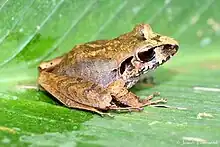| Craugastor laticeps | |
|---|---|
 | |
| Scientific classification | |
| Domain: | Eukaryota |
| Kingdom: | Animalia |
| Phylum: | Chordata |
| Class: | Amphibia |
| Order: | Anura |
| Family: | Craugastoridae |
| Genus: | Craugastor |
| Species: | C. laticeps |
| Binomial name | |
| Craugastor laticeps (Duméril, 1853) | |
| Synonyms | |
|
Eleutherodactylus laticeps (Duméril, 1853) | |
Craugastor laticeps (common name: broad-headed rainfrog, and many variations) is a species of frog in the family Craugastoridae. It is found in Belize, Guatemala, Honduras, and southern Mexico.[2]
Craugastor laticeps occurs in leaf-litter in lowland and premontane tropical forest. It tolerates moderate habitat alteration and can be found in cacao and coffee plantations. There are some threats to this species due to habitat loss.[1]
Reproduction
Craugastor laticeps might be unique among craugastorid frogs (which normally have direct development[3]): one observation suggests that the species is ovoviviparous, ovipositing eggs with fully developed young almost ready to hatch. The female frog in question was 66 mm (2.6 in) in snout–vent length and laid 44 eggs, and the hatching or newly hatched froglets were about 13–14 mm (0.51–0.55 in) in snout–vent length.[4]
References
- 1 2 IUCN SSC Amphibian Specialist Group (2020). "Craugastor laticeps". IUCN Red List of Threatened Species. 2020: e.T143827978A53964706. doi:10.2305/IUCN.UK.2020-3.RLTS.T143827978A53964706.en. Retrieved 16 November 2021.
- ↑ Frost, Darrel R. (2014). "Craugastor laticeps (Duméril, 1853)". Amphibian Species of the World: an Online Reference. Version 6.0. American Museum of Natural History. Retrieved 25 April 2014.
- ↑ Hedges, S. B.; Duellman, W. E. & Heinicke, M. P. (2008). "New World direct-developing frogs (Anura: Terrarana): Molecular phylogeny, classification, biogeography, and conservation" (PDF). Zootaxa. 1737: 1–182. doi:10.11646/zootaxa.1737.1.1.
- ↑ McCranie, J.R.; M.H. Wake; L. Valdés Orellana (2013). "Craugastor laticeps. Possible ovoviviparity". Herpetological Review. 44 (4): 653–654.
